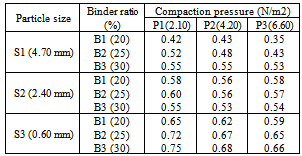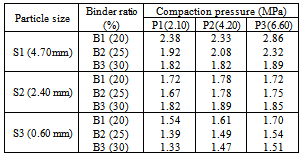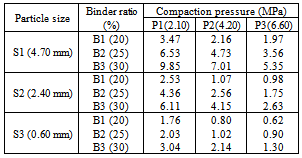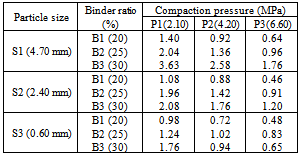-
Paper Information
- Previous Paper
- Paper Submission
-
Journal Information
- About This Journal
- Editorial Board
- Current Issue
- Archive
- Author Guidelines
- Contact Us
International Journal of Energy Engineering
p-ISSN: 2163-1891 e-ISSN: 2163-1905
2012; 2(1): 22-27
doi:10.5923/j.ijee.20120201.04
The Effects of Some Processing Parameters on Physical and Densification Characteristics of Corncob Briquettes
J. T. Oladeji1, C. C. Enweremadu2
1Department of Mechanical Engineering Ladoke Akintola University of Technology, Ogbomoso, P. M.B. 4000, Nigeria
2Department of Mechanical Engineering Vaal University of Technology, Private Bag X021, Vanderbijlpark 1900, South Africa
Correspondence to: J. T. Oladeji, Department of Mechanical Engineering Ladoke Akintola University of Technology, Ogbomoso, P. M.B. 4000, Nigeria.
| Email: |  |
Copyright © 2012 Scientific & Academic Publishing. All Rights Reserved.
Corncobs are generated from maize (Zea mays). The residue is usually dumped and flared on the farms, where it constitutes fire, environmental and health hazards. Corncobs are potential feedstock for energy generation. This work investigated densification characteristics of corncobs. Corncobs were collected from farm dump at a moisture content of 10.96 dry bases, reduced and sieved into three particle sizes S1, S2; and S3. Starch mutillage of 20, 25, and 30 % by weight of the residue was added as binder. The briquettes were produced using briquetting machine at pressures of 2.1, 4.2 and 6.6 MPa. The ASAE standard methods were used to determine the moisture contents and densities of the milled residues and briquettes. The compaction, density and relaxation ratios as well as percentage expansion of the briquettes were determined using ASAE standard methods. The mean moisture content of the corncob residue was 9.64 %, while that of relaxed briquettes was 7.46%. The value of bulk densities of the residue materials was 50.32 kg/m3. The initial, maximum and relaxed densities ranged from 151-235 kg/m3; 533-981kg/m3 and 307-417kg/m3 respectively. The compaction ratio ranged from 2.27 to 6.50. The maximum percentage volume reduction was 626%, while the axial and lateral relaxations were in the range of 0.62-9.85% and 0.64-3.63 respectively. The briquettes were stable up to six months. For the three processing parameters examined, binder ratio B1, particle size S3 and pressure P3 exhibited most positive attributes.
Keywords: Briquettes, Binder Ratio, Compaction Pressure, Corncob. Particle Size, Residue
Cite this paper: J. T. Oladeji, C. C. Enweremadu, The Effects of Some Processing Parameters on Physical and Densification Characteristics of Corncob Briquettes, International Journal of Energy Engineering, Vol. 2 No. 1, 2012, pp. 22-27. doi: 10.5923/j.ijee.20120201.04.
Article Outline
1. Introduction
- Maize (Zea mays) ranks among the three major grain crops grown in Nigeria particularly the southern states of the country ([1]. About 5.3 million hectares of the crop are cultivated yearly[2]. According to Food and Agricultural Organization data[3], 589 million tons of maize was produced world-wide in the year 2005. The United States of America was the largest maize producer having 43% of world production. Africa produced 7% of the world’s maize[4]. Nigeria was the second producer of maize in Africa in the year 2006 with 7.5 million tons[2]. In Nigeria alone, twenty eight different food items can be prepared from maize[5]. South Africa has the highest production of 11.04 million tons[4].Corncob is the agricultural waste product obtained from maize or corn. Maize is mostly harvested and processed for food, leaving a large quantity of corncob residue constituting waste on the farm, most of which are flare off in preparation for subsequent farming season, thereby posing health risks to both human and ecology.The corncob heterogeneous, varying in bulk density, moisture content, particle size and distribution depending on the mode of processing. Corncob is usually of low bulk density with high moisture content of up to 45% when harvested from the farm in partially dried form[6].Many renowned researchers such as Grover and Mishra[7], Singh[8], Olorunnisola[9], Wilaipon[10], and Kaliyan and Morey[11], have worked on various aspects of briquetting, the nature of the materials during and after briquetting. The behaviour and characteristics of biomass briquetting can be classified into physical, mechanical and biochemical processes depending on the measured parameters. Therefore, the main aim of this work was to evaluate the effects of some processing parameters on physical and densification characteristics of briquettes produced from corncob.
2. Materials and Methods
- Corncob residues were obtained from farm dumps and those that were healthy and fungus free were selected. They were sun-dried and their moisture content was determined using ASAE S269.4 2003[12]. The corncob residues were subjected to size reduction process through the use of hammer mill equipped with different screens in compliance residue like any other organic wastes is with procedure described in ASAE 424.1 2003[13]. Three particle sizes S1 (4.70 mm), S2 (2.40 mm) and S3 (0.60 mm) representing coarse, medium and fine series respectively were selected. The bulk density of the unprocessed materials and relaxed briquettes were determined using ASAE standard. Starch mutillage (binder) was added to the residues at 20 (B1), 25 (B2), and 30 % (B3) by weight of the residue. A briquetting machine specially designed and fabricated for formation of briquettes was filled with a fixed charge of residue and compressed manually. Pressures of 2.40 (P1), 4.40 (P2) and 6.60 (P3) MPa were separately applied for each briquette formation. A dwell time of 120 seconds was observed for the briquettes during formation. The initial, maximum and the relaxed densities of the briquettes were determined using the mould dimension, the relaxed briquette’s dimension and ASAE standard method of determining densities.The compaction ratio was obtained from the relationship as expressed in equation (1)
 | (1) |
 | (2) |
 | (3) |
 | (4) |
 | (5) |
3. Results and Discussions
- The sample contained 30.35% of particle size 4.70mm (S1), 20.10% of particle size 2.40mm (S2) and 13.8% of particle size 0.60mm (S3). The particle size analysis showed a preponderance of S1 particle size over the other two particle sizes used in this work. The implication of this observation is that more materials will be required if particle size other than S1 is required for briquetting. However, the particle distribution would depend on the intensity of grinding.The mean moisture content of the residue was 9.64% dry basis. This is within the acceptable operating moisture content of 8 – 12% for making briquetting[7; 14; 15]. However, the moisture content of some materials can be up to 20% and such materials can be densified in a piston press[11]. Moisture content above 10 % might lead to excess steam production, which can lead to explosion as result of dissociation[16]. Besides, an increase in moisture content may not be favourable to the compaction process, as moisture may provide more resistance to formation of briquettes. Furthermore, moisture content in the range of 10% will result in denser, more stable and more durable briquette[16]. The moisture contents obtained in this work are safe for briquette production.The mean bulk density of corncob residue and the relaxed briquettes were 50.32 kg/m3 and 315.00 kg/m3 respectively. This translates to percentage volume reduction of about 626 %. The value of bulk density of raw corncob residue is higher than the minimum value of 40 kg/m3 recommended by[11] for wooden materials, while the value of bulk density of relaxed briquettes obtained is desirable for group packaging and transportation of the briquettes, especially when compared with the initial bulk densities of untreated raw residues, which is 50.32 kg/m3.The density of the uncompressed mixture at different binder ratio and particle size varied from 151 to 235 kg/m3 as shown in Table 1. The density of the uncompressed mixture increased with reduction in the particle size and increased with an increase in the binder ratio level. The implication of this is that the finer the particle, the less the pore spaces and more mass of the material per given volume which is good for briquetting. The effect of the particle size and binder ratio on the density of the uncompressed materials was significant (p<0.05).
|
|
|
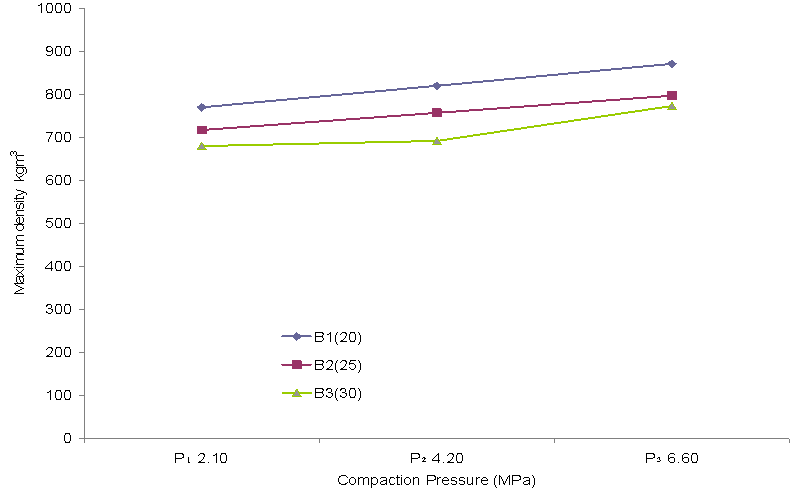 | Figure 1. Effects of Pressure and Binder Ratio on Maximum Density for Briquettes for Particle Size 4.70 mm |
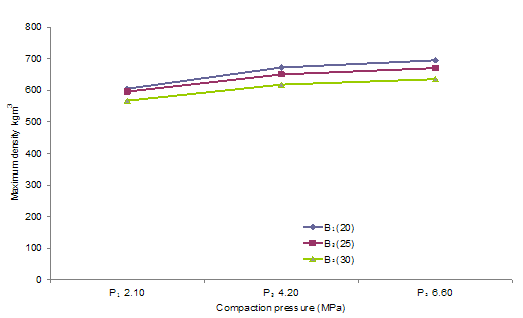 | Figure 2. Effects of Pressure and Binder Ratio on Maximum Density for Briquettes from Corncob from white Maize for Particle Size 2.40 mm |
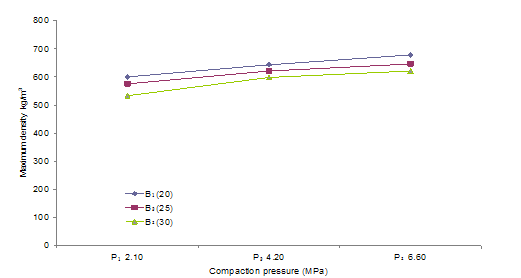 | Figure 3. Effects of Pressure and Binder Ratio on Maximum Density for Briquettes for Particle Size 0.60 mm |
|
|
|
|
|
4. Conclusions and Recommendations
- The present work examined the effects of processing parameters, specifically the effects of compaction pressure; % binder ratio and particle size on physical and combustion characteristics of briquettes produced from corncobs. Based on the various results obtained and the findings of this study, the following conclusions have been made:i. This study has found that, the handling (processing) parameters such as particle size, % binder ratio and compaction pressure significantly affected the physical and densification characteristics of briquettes produced from corncob.ii. Good quality and highly storable briquettes can be produced from the blend of corncob and cassava starch gel. This is because the briquettes produced have sufficient density and relaxed density. Furthermore, the shelf-life of the stored briquettes showed reasonable stability even after six months of storage.iii. The bulk density of the relaxed briquettes, which is 315 kg/m3 is higher than the residue materials, which is 50.32 kg/m3. This translated into 626% volume reduction. It also provides technological benefits and a desirable situation for material storage, packaging and transportation.iv. For all the three processing parameters examined in this study, variables with particle size S3, (0.60 mm), binder ratio B1 (20%) and compaction pressure P3 (6.6 MPa) exhibited the most positive attributes than the other two variables. It can then be concluded that, the finer the particle size is, the more positive attributes of good quality briquette such particle has. In the similar manner, the lower the binder ratio, the better the briquettes, while higher compaction pressure will result in more quality briquettes.
 Abstract
Abstract Reference
Reference Full-Text PDF
Full-Text PDF Full-text HTML
Full-text HTML



